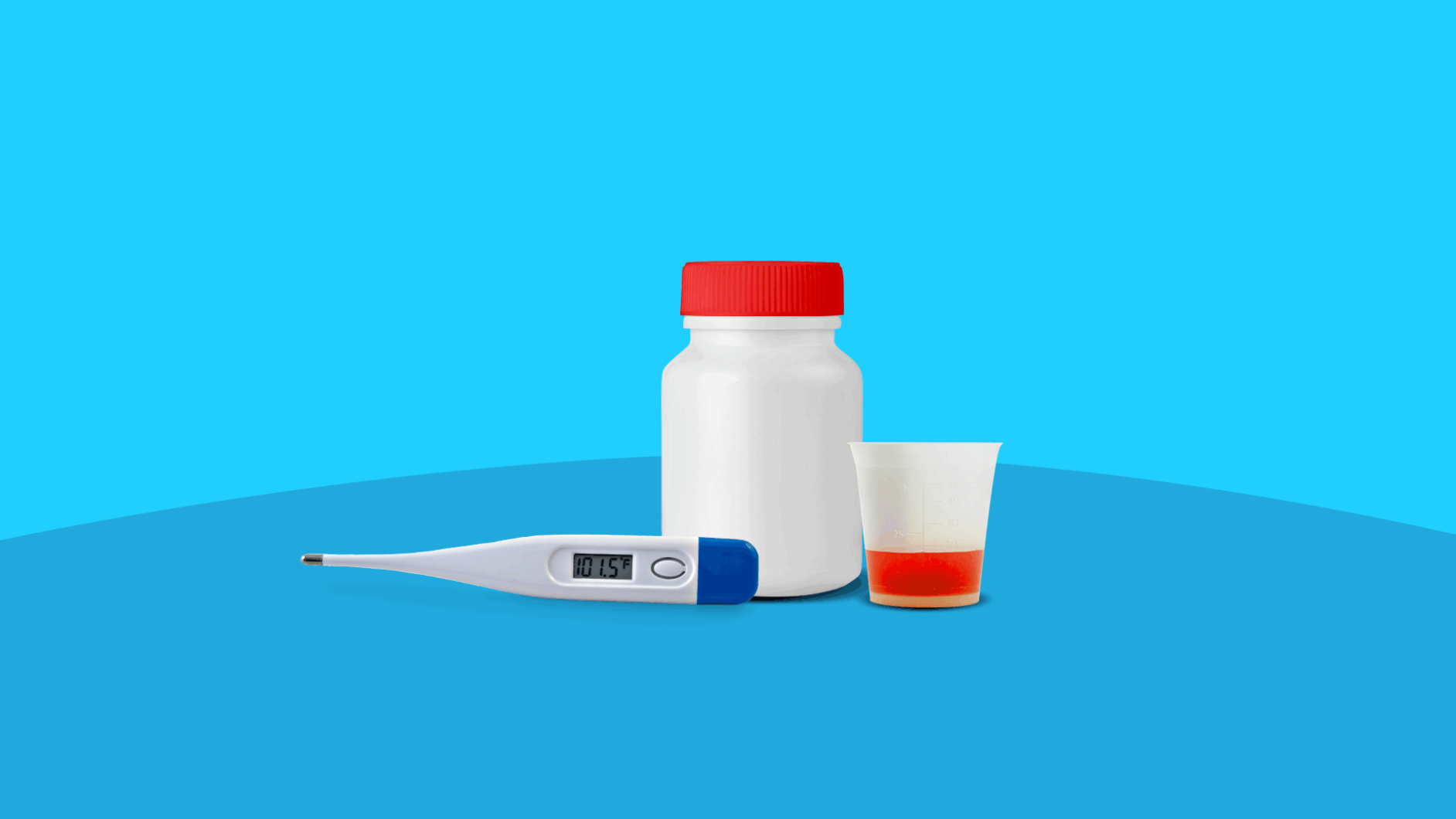Normal body temperature | What is a fever? | Types of fevers | Fever temperature chart | Causes | Treatments | When to call a doctor
Take a look at the sick leave guidelines for most schools and workplaces, and you’re bound to find a reference to fevers. The general consensus for higher-than-normal body temperatures is to stay home. But why? After all, a fever is not a disease. It’s an indicator.
While a fever might be uncomfortable (and even slightly worrisome), it’s not inherently bad. A high temperature is the body’s way of fighting an infection or responding to a traumatic injury. It’s a natural bodily response, a sign that the immune system is gearing up for a battle.
Still, questions remain. And with the growing prevalence of fevers as a coronavirus (COVID-19) symptom, you might be wondering how to tackle a fever. What are the different types of fevers? When is a fever too high? How do you treat one? Those answers (and more) are just a short scroll away.
What is a normal body temperature?
A normal body temperature is 98.6 degrees Fahrenheit or 37 degrees Celsius. At least, that’s the conventional answer. However, studies suggest that the actual body temperature of humans may run closer to 97.5 degrees Fahrenheit. Still, according to the Journal of Infection and Public Health, the normal body temperature usually ranges between 98.6 and 100.4 degrees Fahrenheit.
There are a few important considerations regarding body temperatures, though. A person’s temperature can be influenced by several factors, including:
- Strenuous exercise
- Stress
- Smoking
- Gender
- Pregnancy
- Food and drinks
- Weather
- Time of day when the temperature is taken
Remember that body temperatures can vary based on where the measurement is taken. Rectal and ear temperatures are higher (and more accurate) than oral and armpit temperatures.
It’s also important to consider the age of the person. In children, the normal temperature can differ from that of adults.
| Normal temperature ranges | |
|---|---|
| Measurement method | Normal temperature range |
| Rectal | 36.6°C to 38°C (97.9°F to 100.4°F) |
| Ear | 35.8°C to 38°C (96.4°F to 100.4°F) |
| Oral | 35.5°C to 37.5°C (95.9° to 99.5°F) |
| Axillary | 34.7° to 37.3°C (94.5°F to 99.1°F) |
What is a fever?
So what constitutes a fever? Depending on where you look, you might find different values for what is considered a fever. The answer is it depends, as everyone’s body runs at a slightly different normal temperature. The average body temperature is 98.6 degrees Fahrenheit, and anything above 100.4 F usually indicates a fever.
Fever symptoms
A fever is usually a symptom in and of itself caused by an infection or other condition. But a fever often occurs along with other signs and symptoms. These might include:
- Headache
- Muscle aches
- Dehydration
- Chills or shivering
- Fatigue
- Flushing of the skin
- Sweating
- Weakness
- Changes in appetite
In some cases, a fever can develop without other symptoms. The symptoms that develop with a fever will depend on the condition or infection causing the fever in the first place.
Types of fevers
Fevers can be described in a number of ways, such as low-grade, moderate-grade, or high-grade. The range that a fever can fall within can vary depending on a person’s normal body temperature. However, a fever is usually classified as follows:
- Low-grade fever: 100.5 to 102.2 degrees Fahrenheit
- Moderate-grade fever: 102.2 to 104.0 degrees Fahrenheit
- High-grade fever: 104.1 to 106.0 degrees Fahrenheit
Hyperpyrexia occurs when the body’s temperature rises over 106 degrees Fahrenheit and indicates a severe underlying issue that requires emergency medical care. If it’s not controlled, an extremely high temperature can potentially cause permanent brain damage and even death. Symptoms that accompany hyperpyrexia include nausea, vomiting, headache, and confusion, which often require medical attention.
The timeline of symptoms can also dictate how a fever is classified. An acute fever lasts less than seven days, a subacute fever lasts between seven and 14 days, and a chronic fever lasts more than 14 days. Some fevers may also have different patterns. For example, an intermittent fever is a fever that occurs only for several hours during a 24-hour period.
Fever temperature chart
| Normal and febrile body temperature ranges (rectal temperatures) | ||
|---|---|---|
| Body temperature | °C | °F |
| Normal | 37-38 | 98.6-100.4 |
| Mild/low grade fever | 38.1-39 | 100.5-102.2 |
| Moderate grade fever | 39.1-40 | 102.2-104.0 |
| High grade fever | 40.1-41.1 | 104.1-106.0 |
| Hyperpyrexia | >41.1 | >106.0 |
Causes of fevers
Fevers can be caused by an array of different problems, and knowing the underlying cause is important to treat a fever. Examples of fever causes include:
- Viral or bacterial infections
- Medication side effects
- Vaccines
- Blood clots
- Severe sunburn
- Certain inflammatory diseases, such as Crohn’s disease
- Cancer
- Teething (in infants)
Any of these conditions or illnesses may trigger a fever through different immune processes. However, the hypothalamus is the part of the brain that regulates the body’s temperature. In tandem with processes in the immune system, the hypothalamus can increase the temperature of the body.
A fever can also develop due to hyperthermia, which occurs when the body is unable to regulate its temperature. In a high-heat environment, the body’s temperature-regulating systems can break down. Unable to release more heat than it can absorb, the body can overheat.
Body temperature chart for children |
||
|---|---|---|
| Celsius | Fahrenheit | |
| Hypothermia | < 35.0° | < 95.0° |
| Normal | 35.8° – 37.5° | 96.4° – 99.5° |
| Hyperthermia (low-grade fever) | > 38.0° | > 100.4° |
| Hyperpyrexia (high fever) | > 40.0° | > 104.0° |
Body temperature chart for adults |
||
|---|---|---|
| Celsius | Fahrenheit | |
| Hypothermia | < 35.0° | < 95.0° |
| Normal | 36.5° – 37.5° | 97.7° – 99.5° |
| Hyperthermia (low-grade fever) | > 38.3° | > 100.9° |
| Hyperpyrexia (high fever) | > 41.5° | > 106.7° |
Note: These charts reflect rectal temperatures, which are typically one degree (Fahrenheit) higher than oral or armpit temperatures.
Treating a fever
In most cases, a fever will come and go without doing any harm. Because they help the body fight off infections, it’s often best to let low-grade fevers run their course. A fever will usually last one to three days. However, if the fever gets worse or remains persistent, it may be time to seek help from a healthcare provider.
Although a high-grade fever may require more serious measures, a mild- to moderate-grade fever can usually be treated at home with the following:
Getting plenty of rest
Rest is critical for allowing the body to recover and fight the underlying cause of the fever. Keeping physical activity to a minimum can also help prevent any sudden spikes in body temperature.
Keeping the body hydrated
Fevers can induce sweating, so staying hydrated is vital. Drinking cold water won’t always lower a high temperature, but it can help mitigate symptoms and discomfort. Other ways to stay hydrated include drinking clear broth, or juice. Children under six months of age should only be given formula or breast milk.
Staying cool and comfortable
Dressing in airy clothing, using light blankets, and taking lukewarm baths can help keep the body cool and comfortable. It might seem like an ice bath would tackle a fever even better, but this isn’t the case. Ice baths can cause shivering, which could raise core body temperature.
Over-the-counter medications
Over-the-counter medications like ibuprofen (Advil) and acetaminophen (Tylenol) are effective in reducing fevers. They can also help relieve mild discomfort, aches, and pains associated with fevers. Just make sure to check the drug label or consult with a healthcare provider for proper dosages and instructions in children.
Prescription drugs
A healthcare provider may prescribe a prescription medication, such as an antibiotic, to address the underlying cause of the fever. A fever and other symptoms should start to subside with antibiotics if a bacterial infection is causing the fever.
RELATED: What’s the best pain reliever or fever reducer for kids?
When to call a doctor
Dealing with a fever can be a stressful experience. Usually, there should be no reason to panic with a fever. However, it’s good to keep some things in mind regarding when you should seek medical attention for a fever.
Fever is also one of the most common COVID-19 symptoms. Anyone with a fever and a dry cough or difficulty breathing should get tested for coronavirus as soon as possible.
Fever in adults
Certain scenarios may call for a visit to a healthcare provider. You should seek help from a healthcare provider or, in some cases, go straight to an emergency room if you experience any of the following with a fever.
- Fever with a body temperature of 103 degrees Fahrenheit or higher
- Severe chest pain
- Difficulty breathing
- Severe confusion or changes in behavior
- Severe headache
- Stiffness or pain in the neck when bending the head forward
- Dizziness or lightheadedness
- Seizures
- Skin rash
- Pain around the abdomen
- Severe nausea and vomiting that doesn’t go away
- Pain upon urination
Fever in children and infants
Children and infants have lower temperature thresholds for fevers because of the potential damage they can cause. You should monitor your child’s fever closely and seek help from a healthcare provider if you find any of the following:
- A temperature of 100.4 degrees Fahrenheit (38 degrees Celsius) or more in an infant younger than three months old
- A temperature of 102 degrees Fahrenheit (38.9 degrees Celsius) or more in an infant between three and six months old
- A fever that lasts longer than two days in an infant or child older than three months
Accompanying symptoms of a fever, such as:
- Severe or unusual rash
- Appearing confused or listless
- Severe fatigue or drowsiness
- Difficulty breathing
- No longer eating or drinking
- Irritability
- Vomiting
Children and infants may also experience febrile seizures in severe cases. These seizures may cause uncontrollable shaking or a loss of consciousness. If a seizure lasts more than five minutes, call 911 immediately.
Bottom line
Most of the time, a low-grade fever is beneficial for the body to fight infections. Once a fever starts increasing past a certain threshold, however, there can be dire consequences. It’s also important to monitor how fast the temperature is rising. A fever with a high temperature that rises quickly or doesn’t go away (usually within a few days) is a cause for concern. You can always consult with a healthcare provider for professional medical advice on how to treat a fever if you have any doubts or concerns.











